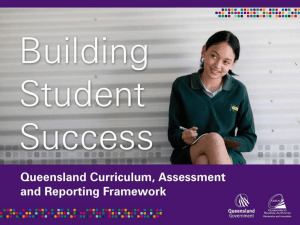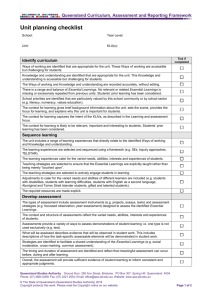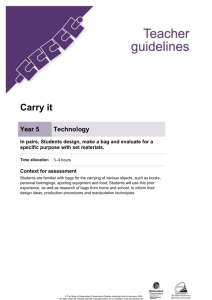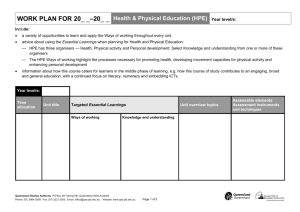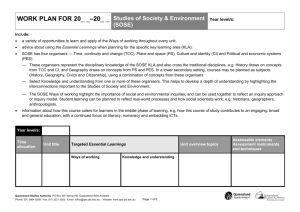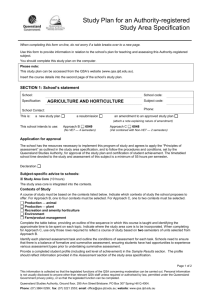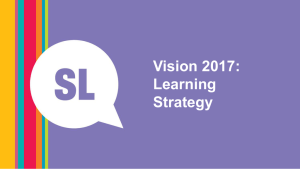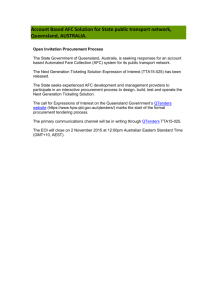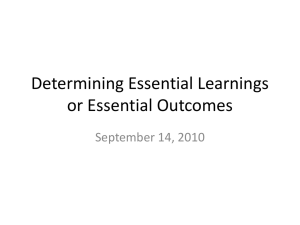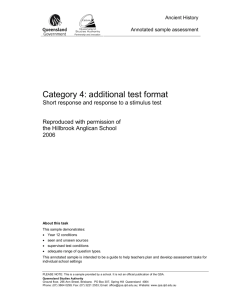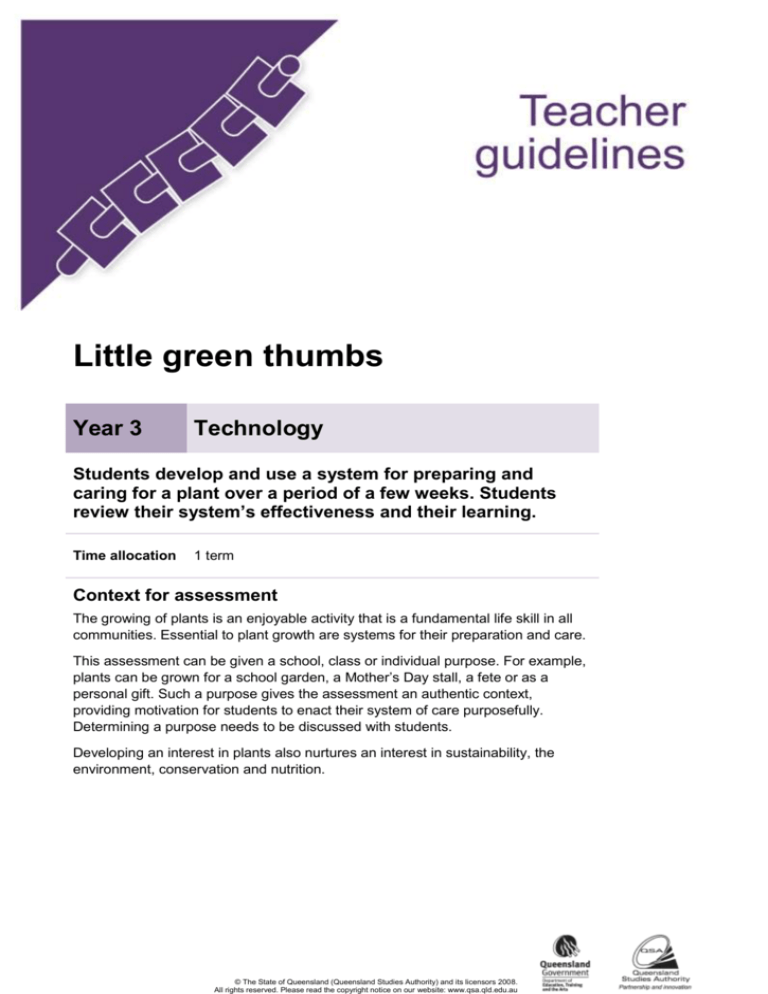
Little green thumbs
Year 3
Technology
Students develop and use a system for preparing and
caring for a plant over a period of a few weeks. Students
review their system’s effectiveness and their learning.
Time allocation
1 term
Context for assessment
The growing of plants is an enjoyable activity that is a fundamental life skill in all
communities. Essential to plant growth are systems for their preparation and care.
This assessment can be given a school, class or individual purpose. For example,
plants can be grown for a school garden, a Mother’s Day stall, a fete or as a
personal gift. Such a purpose gives the assessment an authentic context,
providing motivation for students to enact their system of care purposefully.
Determining a purpose needs to be discussed with students.
Developing an interest in plants also nurtures an interest in sustainability, the
environment, conservation and nutrition.
© The State of Queensland (Queensland Studies Authority) and its licensors 2008.
All rights reserved. Please read the copyright notice on our website: www.qsa.qld.edu.au
Teacher guidelines
This assessment gathers evidence of learning for the following Essential Learnings:
Technology
Essential Learnings by the end of Year 3
Ways of working
Knowledge and understanding
Students are able to:
Technology as a human endeavour
select resources, simple techniques and
tools to make products
Technology is part of our everyday lives and
activities.
plan and sequence main steps in
production procedures
make products by following production
procedures to manipulate and process
resources
Information, materials and systems
(resources)
follow guidelines to apply safe practices
Resources are used to make products for
particular purposes and contexts.
evaluate products and processes by
identifying what worked well, what did not
and ways to improve
reflect on learning to identify new
understandings.
Products include artefacts, systems and
environments.
Simple techniques and tools are used to
manipulate and process resources.
Assessable elements
Knowledge and understanding
Investigating and designing
Producing
Evaluating
Reflecting
Source: Queensland Studies Authority 2007, Technology Essential Learnings by the end of Year 3, QSA, Brisbane.
2
Year 3 Technology: Little green thumbs
Links to other KLAs
This assessment could be expanded to assess the following Essential Learnings:
Science
Essential Learnings by the end of Year 3
Ways of working
Knowledge and understanding
Students are able to:
Science as human endeavour
pose questions and make
predictions
Science is part of everyday activities and
experiences.
plan activities and simple
investigations, and identify
elements of a fair test
identify and collect data,
information and evidence
use identified tools, technologies
and materials
draw conclusions and give
explanations, using data,
information and evidence
follow guidelines to apply safe
practices.
Stewardship of the environment involves conserving
natural resources.
Life and living
Needs, features and functions of living things are
related and change over time.
Change occurs during the life cycle of living things.
Living things depend on the environment and each
other.
Source: Queensland Studies Authority 2007, Science Essential Learnings by the end of Year 3, QSA, Brisbane.
SOSE
Essential Learnings by the end of Year 3
Ways of working
Knowledge and understanding
Students are able to:
Place and space
Pose questions for
investigations
Plan simple investigations based
on questions
Share ideas, and plan and enact
responses to group or
community issues
Participate in group decision
making to achieve goals.
Local natural, social and built environments are
defined by specific features and can be sustained by
certain activities.
Resources and environments can be used,
conserved and protected by valuing and applying
sustainable practices.
Source: Queensland Studies Authority 2007, SOSE Essential Learnings by the end of Year 3, QSA, Brisbane.
3
Teacher guidelines
Listed here are suggested learning experiences for students before attempting this assessment.
Investigate types of resources and materials used in plant care and preparation.
Identify safety considerations when working outdoors and with plant related resources and
materials.
Practise techniques for using gardening tools correctly and safely.
Explore the concept of “system” in school settings (e.g. collecting food from the tuckshop, class
placement and movement on assembly, emergency drills, payments for field trips, delivering
messages around the school, keeping the room tidy).
Write logical sequences, steps and actions (systems) for doing things using other real-life
contexts (e.g. brushing teeth, getting dressed, making a cake).
Review reflection practices – why should we reflect and how we can reflect.
Observe a teacher or other student planting a tree or shrub seedling from a large pot into the
ground. This should be accompanied by relevant discussion. Students may also be able to do
this if enough seedlings can be sourced.
Observe and practise the planting of seeds in a seedling tray, fruit box lid or similar container
with relevant conversation and discussion.
Investigate a variety or purposes for growing and caring for plants.
Teacher resources
Association of Societies for Growing Australian Plants: <http://asgap.org.au/whereto4.html>.
Brisbane City Council – Sustainable future:
<www.brisbane.qld.gov.au/BCC:BASE:733436863:pc=PC_678>.
Bushcare Services:<www.bushcare.com.au>.
Greenhouse: <www.greenhouse.gov.au/education/index.html>.
Greening Australia: <www.greeningaustralia.org.au>.
Origin Energy: <http://originenergy.com.au/hep>.
Queensland Government:
<www.epa.qld.gov.au/nature_conservation/plants/growing_native_plants>.
Sustainability Education: <www.environment.gov.au/education>.
Victorian Government:
<www.betterhealth.vic.gov.au/BHCV2/bhcarticles.nsf/pages/Gardening_for_children?Open>.
4
Year 3 Technology: Little green thumbs
Preparing
Consider these points before implementing the assessment.
Collect a variety of tools and materials for students to prepare and care for their plant. Seek
assistance from parents, local councils and nurseries within the local community for expertise
and resources if required.
The use of shade cloth or insect screen may be required to protect plants from insects. Also
consider the protection of plants on weekends.
The purpose of potting and caring for the plant must be discussed initially with students. With a
clear purpose (e.g. junior school garden, Mother’s Day gift etc.) students will have an authentic
reason to enact their system of care and review it purposefully.
The choice of seeds or seedlings and plant type will be influenced by whether the purpose is
short or long term. For shorter term plant options it is preferable to use seedlings. The choice
of plants suitable for local conditions could be part of an initial investigation by students. Beans,
sunflowers, snow peas, onions, tomatoes and strawberries are possible short term choices.
The use of native plants is also encouraged although the amount of time for plant growth will
be a consideration.
If teachers are concerned that plants may die early in the process regardless of the system,
consideration should be given to students caring for two plants of different types or working as
a small group to look after several plants.
Judgments will not be made on the final product but on the processes followed by students
during the assessment. This needs to be emphasised to students so that they do not feel
discouraged if their plant dies or is damaged by an unforseen circumstance.
Risk assessment
Sun safety: Students must adhere to the school sun safety policy when outdoors.
Child protection: If students are caring for plants away from the classroom, adult supervision
must be considered, or students should work in pairs or small groups.
Tool usage: Teacher modelling of the correct techniques for tool and materials use must occur
prior to students use.
Safety rules should be discussed and followed. Refer to Resources for the assessment.
Information Communication Technology
There are opportunities to:
create a slide show of the plant-potting sequence
take digital photographs related to the systems of plant preparation and care, to use as a
stimulus for writing and speaking activities or for feedback and reflection.
5
Teacher guidelines
Sample implementation plan
This table shows one way that this assessment can be implemented. It is a guide only — you may
choose to use all, part, or none of the table. You may customise the table to suit your students and
their school environment.
Suggested time
Student activity
Teacher role
Section 1. Purpose and preparation
10–20 minutes
5–10 minutes per
child
Write a plan for
preparing their plant
in a pot.
Model how to write a system of preparation prior to this aspect
of the assessment.
Prepare a plant in a
pot following their
written plan.
Provide a variety of tools and materials for students to prepare
their plant.
Remind students to write the plant preparation process in
order of sequence (e.g. first … then …).
Observe each child as they prepare their plant.
Section 2. System of care
30 minutes
Write a system for
caring for their
plant.
It is important for students to have some variety in how they
care for their plants. If everyone has the same system it is
likely that the results will all be the same.
Some students may need support with the written aspect of
this section — a simple flow chart could be used to develop
knowledge.
Section 3. Observation log
Students need
several weeks to
enact their system
of care for their
plant.
Maintain an
observation log
relating to the care
of their plant.
Reflect and seek
feedback along the
way.
Ensure safety considerations are enforced when students
enact their systems.
If some plants wilt, die or flourish, this is an opportunity for
students to reflect on their system and its effectiveness.
It is not the purpose of this assessment to have perfect plants
but rather that students learn that systems influence plant
growth for better or worse.
Section 4. Check your system
Part 1
30 minutes
Part 2
10–20 minutes
6
Consider their
system and
suggest possible
improvements.
The review should only happen after a reasonable period of
time (e.g. 3-4 weeks). If students wish to change their system
prior to the teacher implementing this section of the
assessment, they should note their changes in the log.
Answer reflection
questions and then
discuss learning
with their peers.
Read through the questions giving students time to answer.
Discussion could firstly be with a peer and then with a larger
group or the whole class.
Year 3 Technology: Little green thumbs
Resources for the assessment
A variety of pots of different sizes
Potting mix, fertiliser, gravel, dirt, sand
Tools — trowels, spades, forks, spoons, gloves, watering containers (small and large)
Mix of vegetable seeds and quick growing annual flower seeds or seedlings
Tags for pots — identify student and seed type
Insect screen
Stakes
Water
Websites for health and safety information
Technology (2003) sourcebook guidelines (PDF) includes comprehensive safety guidelines in
Appendix B. This document can be found on the Queensland Studies Authority website at:
<http://www.qsa.qld.edu.au/syllabus/842.html>.
Department of Education Manual contains instructions on safety practices in the classroom.
Available to EQ schools only at: <http://education.qld.gov.au/corporate/doem>.
Workplace Health and Safety Act 1995 (PDF) is available on the Department of Employment
and Industrial Relations website at: <http://www.deir.qld.gov.au/workplace/law/index.htm>.
7
Teacher guidelines
During the learning process, you and your students should have developed a shared
understanding of the curriculum expectations identified as part of the planning process.
After students have completed the assessment, identify, gather and interpret the information
provided in student responses. Use only the evidence in student responses to make your judgment
about the quality of the student learning. Refer to the following documents to assist you in making
standards-referenced judgments:
Guide to making judgments
Indicative A response
Sample responses (where available).
Making judgments about this assessment
While it is hopeful that all students will grow a plant that is beautiful, it is likely for a variety of
reasons that this may not occur. Emphasis is therefore not on judging the final product but rather
the processes followed by students throughout the assessment. This needs to be emphasised to
students so that they do not feel discouraged if their plant dies or is damaged by an unforseen
circumstance. This emphasis is reflected in the Guide to making judgments.
For further information, refer to the resource Using a Guide to making judgments,
available in the Resources section of the Assessment Bank website.
Evaluate the information gathered from the assessment to inform teaching and learning strategies.
Involve students in the feedback process. Give students opportunities to ask follow-up questions
and share their learning observations or experiences.
Focus feedback on the student’s personal progress. Emphasise continuous progress relative to
their previous achievement and to the learning expectations — avoid comparing a student with
their classmates.
Giving feedback about this assessment
While feedback in this assessment should be regular from the teacher, the student will receive
feedback from the plant through its growth — an obvious but important consideration. The teacher
may also wish to access specialist nursery workers or scientists to provide feedback to students
about their systems of care.
For further information, refer to the resource Using feedback, available in the
Resources section of the Assessment Bank website.
8

